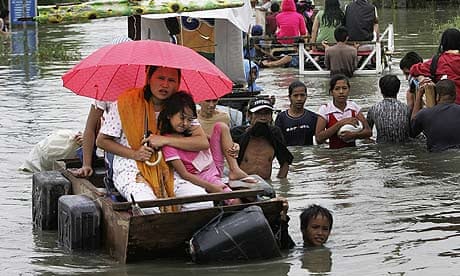Typhoon Parma slammed into the Philippines today, killing at least two people, ripping off roofs, toppling power pylons and swelling rivers in the country's mountainous north.
The storm is the country's second in eight days and cut a path across the north-eastern tip of the main island of Luzon en route for Taiwan, where evacuations of southern villages were under way.
The capital, Manila, escaped the worst of the storm. The city was still reeling from a storm a week ago that caused the worst flooding in four decades, killing at least 288 people and damaging the homes of 3 million more.
The provinces of Cagayan and Isabela were hardest hit today by powerful winds and drenching rain, which cut off some communications and roads.
"The damage is quite heavy," the Cagayan police chief, Roberto Damian, told ABC-CBN television. "We are clearing highways and roads to reach people calling for rescue."
In Isabela, one man drowned and another died from exposure to the cold and wet weather, said Lieutenant Colibek Loreto Magundayao, from an army division based in the province.
Tens of thousands of people were moved to safe ground across the Philippines ahead of the typhoon, though officials said the threat of another national disaster eased as Parma changed course last night and bypassed the capital, parts of which are still chest-deep in floodwaters.
Trees were uprooted and power poles toppled in the provincial capital of Tuguegarao, a Cagayan local government official, Bonifacio Cuarteros, said. Buildings had their roofs torn off and similar damage was reported in neighbouring Isabela.
Parma hit the coast with sustained winds of 108mph, though they weakened as the storm passed overland, the national weather bureau said.
The weather bureau's chief Prisco Nilo warned that the heavy rain could trigger landslides and flooding, and strong winds could create tidal surges "similar to a tsunami" along the eastern coast.
After the storm changed course, officials began returning tens of thousands of people who had been evacuated from coastal areas.
Taiwan issued a storm warning and began moving people out of villages in the southern county of Kaohsiung, local official Lin Chun-chieh said. Flash floods froma typhoon in August killed about 700 people in the Kaosiung area.
The earlier storm to hit the Philippines, Ketsana, went on to hit other south-east Asian countries, killing 99 in Vietnam, 14 in Cambodia and 16 in Laos.
The storms were just part of more than a week of devastation in the Asia-Pacific region that has claimed more than 1,500 lives so far: an earthquake on Wednesday in Indonesia; a tsunami on Tuesday in the Samoan islands; and Typhoon Ketsana across south-east Asia.
Another typhoon, Melor, was churning in the Philippine Sea, 1,600 miles to the east, threatening the US territory of the Northern Mariana islands.
Most businesses there were shut today, and residents of the island of Saipan who don't live in concrete homes moved to typhoon shelters, said a government spokesman.
President Gloria Macapagal Arroyo declared a nationwide disaster yesterday to allow local governments to access emergency funds and cap the prices of essential goods. She also ordered troops to evacuate more than 100,000 people from areas at risk from the typhoon, Reuters reported.
Officials said some 5.5bn pesos (£72m) in crops, mostly rice about to be harvested, were damaged by Ketsana last week. The damage to bridges and roads was estimated at 1.6bn pesos.
Arroyo ordered a one-year deferment in repayment of loans provided by state pension funds, part of liquidity-boosting measures to protect the economy following the devastation.


